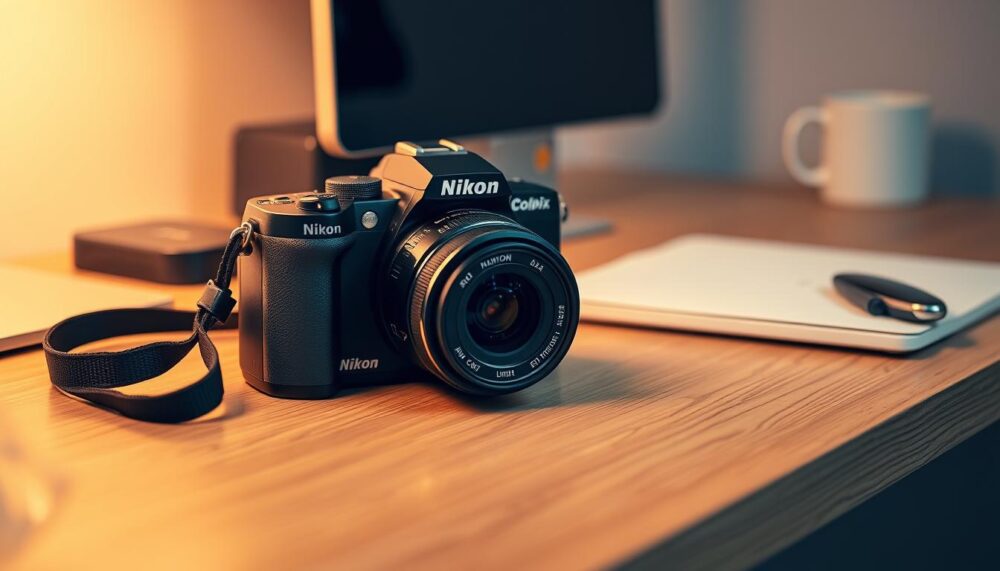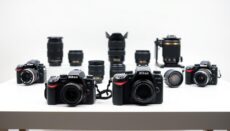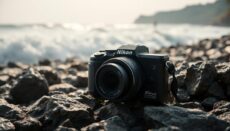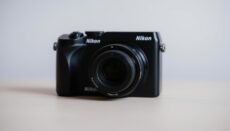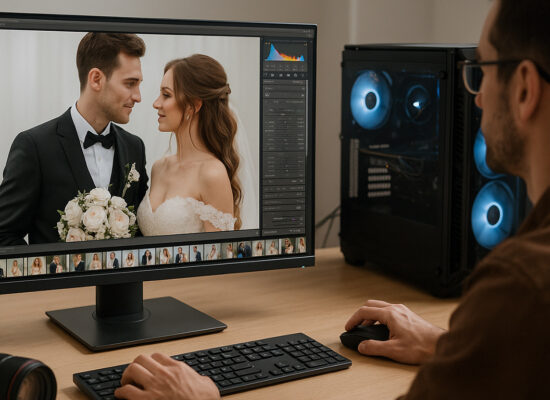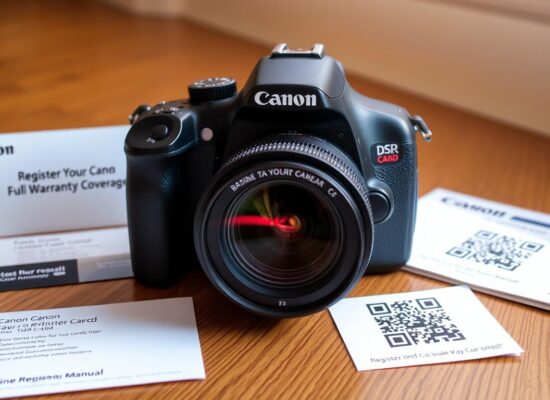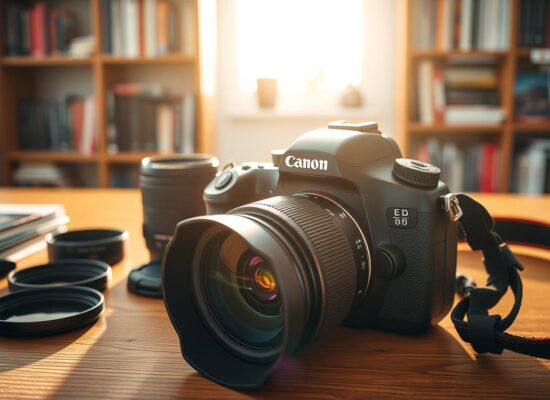In the ever-evolving world of photography, staying relevant is crucial. The Nikon Coolpix P1100, released in 2025, raises questions about its place in the modern market. With a 16MP 1/2.3″ sensor carried over from 2018, some may wonder if it can compete with today’s advancements.
This model introduces USB-C charging, aligning with EU compliance standards. Its standout feature remains the 125x optical zoom, offering a 24-3000mm equivalent range. But does this extreme zoom justify its position in a market dominated by smartphone innovations?
This review delves into the camera’s performance, handling, and value. We’ll explore whether it holds up against modern alternatives and if it’s a worthy investment for enthusiasts in 2025.
Key Takeaways
- The Nikon Coolpix P1100 retains a 16MP sensor from 2018.
- USB-C charging has been added for compliance with EU standards.
- It features a 125x optical zoom, equivalent to 24-3000mm.
- Competes with advancements in smartphone photography.
- Assessed on performance, handling, and overall value.
Introduction to Nikon Coolpix Cameras in 2025
In 2025, the photography landscape continues to shift, with smartphones dominating the scene. Despite this, bridge cameras like the Nikon Coolpix series maintain a niche appeal. These devices cater to enthusiasts who require optical reach beyond what smartphones can offer.
Wildlife and travel photographers, in particular, sustain the demand for such tools. The ability to capture distant subjects with precision remains a key advantage. Nikon’s 2025 lineup includes the P950 and P1100, both designed to meet these specialised needs.
The P950, with its 83x zoom, remains available at £849. Meanwhile, the P1100, priced at £1049, offers a 125x optical zoom. While the upgrades are minimal, the latter’s extended range appeals to those seeking unparalleled versatility.
Compared to mirrorless systems, Nikon Coolpix models stand out for their compact design and affordability. However, their reliance on smaller sensors raises questions about long-term sustainability in a market increasingly focused on image quality.
| Model | Zoom Range | Price |
|---|---|---|
| P950 | 83x | £849 |
| P1100 | 125x | £1049 |
For enthusiasts, the superzoom concept remains compelling. Yet, as smartphone technology advances, the future of such devices depends on their ability to adapt. Nikon’s 2025 offerings suggest a commitment to this niche, but only time will tell if it’s enough.
Key Features of Nikon Coolpix Cameras
Modern photography demands equipment that adapts to diverse shooting scenarios. The Nikon Coolpix series, particularly the P1100, offers a blend of advanced features and practical functionality. Let’s explore the key aspects that define these devices.
Sensor and Lens Technology
The P1100 retains a 1/2.3″ CMOS sensor, unchanged since 2018. While this ensures compatibility with existing accessories, it also highlights limitations in low-light performance. The lens technology, however, compensates with a variable aperture of f/2.8-8, allowing flexibility in various lighting conditions.
Zoom Capabilities and Aperture Range
One of the standout features is the 125x optical zoom, equivalent to a 24-3000mm focal length. This range is ideal for wildlife and sports photography, where capturing distant subjects is crucial. The trade-off between optical and digital zoom is minimal, ensuring image quality remains consistent.
Video Recording and Connectivity Options
For videographers, the P1100 supports 4K/30p recording with a 3.5mm mic input, enhancing audio quality. Connectivity has also improved with the adoption of USB-C charging, a step forward from the Micro USB used in the P950. This aligns with modern standards, offering faster and more reliable power solutions.
| Feature | Details |
|---|---|
| Sensor | 1/2.3″ CMOS |
| Lens Aperture | f/2.8-8 |
| Zoom Range | 24-3000mm (125x optical) |
| Video Resolution | 4K/30p |
| Charging Port | USB-C |
These features make the P1100 a versatile tool for enthusiasts. While it may not match the advancements of smartphones in some areas, its specialised capabilities ensure it remains a valuable option for specific photography needs.
Performance and Image Quality
Evaluating the performance of any device requires a deep dive into its core functionalities. For the P1100, its image quality is a critical factor, especially when compared to modern alternatives. Let’s explore how it fares in low-light conditions, sharpness, and colour accuracy.
Low Light Performance
In dimly lit environments, the sensor struggles to maintain clarity. Noise becomes noticeable at ISO 800 and above, which limits its usability in challenging lighting. While the variable aperture helps, the smaller sensor size impacts light absorption, resulting in grainy images.
For those who frequently shoot in low light, this could be a significant drawback. However, adjusting the shutter speed and using external lighting can mitigate some of these issues.
Image Sharpness and Colour Accuracy
The 16MP resolution, while sufficient for casual use, limits cropping potential. This is particularly evident when zooming in on distant subjects. The image quality remains sharp at lower ISOs, but detail retention diminishes as the ISO increases.
Colour accuracy has been described as “dull” in sample images. The exposure settings can be adjusted to enhance vibrancy, but the default profile lacks the richness found in competitors. This is a trade-off for the device’s affordability and compact design.
“The dynamic range is limited, which affects the ability to capture high-contrast scenes effectively.”
RAW shooting offers some flexibility in post-processing, but the inherent limitations of the sensor remain. For enthusiasts seeking versatility, this may not be the ideal choice. However, for specific use cases like wildlife photography, the extreme zoom compensates for some of these shortcomings.
Usability and Handling
When it comes to handling a device, comfort and intuitiveness are paramount. The body of the P950, weighing 1005g with the battery, feels substantial yet manageable. Its DSLR-style design ensures a secure grip, making it suitable for extended use during outdoor shoots.
Design and Build Quality
The dual dials and well-placed buttons enhance the overall ergonomics. Compared to modern mirrorless systems, the control layout is familiar, though slightly bulkier. The body is robust, but the weight might be a concern for those seeking portability.
Menu System and Controls
The menu system is straightforward, though it lacks the touch functionality found in newer models. Navigating through settings is intuitive, thanks to the logical arrangement of options. The dual dials allow quick adjustments, while the buttons provide easy access to frequently used features.
However, the non-touch 3.2″ LCD screen with a 921k-dot resolution feels outdated. While it’s bright enough for outdoor use, the lack of touch responsiveness can slow down operations. The electronic viewfinder performs adequately, though it’s not as sharp as those found in higher-end models.
“The ergonomics are solid, but the screen’s limitations are noticeable in fast-paced shooting scenarios.”
In summary, the handling of the P950 strikes a balance between functionality and comfort. While the screen and viewfinder could benefit from upgrades, the overall design and control layout remain practical for enthusiasts.
Are Nikon Coolpix Cameras Good for Photography Enthusiasts?
For photography enthusiasts, choosing the right tool is essential for capturing stunning images. The Nikon Coolpix series, with its unique features, caters to specific needs but also has limitations.
Wildlife photography is one area where these devices excel. The 125x optical zoom allows users to capture distant subjects with precision. However, the 4fps burst shooting limits its effectiveness in fast-paced action scenarios.
Manual controls are a highlight, offering enthusiasts creative freedom. Adjusting settings like aperture and shutter speed enhances the camera’s versatility. This makes it a valuable tool for those looking to experiment with different modes.
When compared to entry-level mirrorless systems, the Coolpix series falls short in some areas. The lack of interchangeable lenses restricts adaptability, a feature many enthusiasts value. However, its compact design and affordability make it a practical choice for beginners.
- Ideal for wildlife and travel photography due to extreme zoom capabilities.
- Manual controls provide creative flexibility for enthusiasts.
- Limited burst shooting restricts action photography.
- No lens interchangeability reduces versatility compared to mirrorless systems.
- Educational value for beginners learning the basics of photography.
For beginners, the Coolpix series offers a solid foundation. Its straightforward controls and specialised features encourage skill development. While it may not match advanced systems, it remains a practical option for those starting their photography journey.
Comparison with Competing Brands
Choosing the right camera often involves comparing features, performance, and value across brands. In this section, we’ll evaluate how the Nikon Coolpix series stacks up against the Fujifilm X Series and Sony CyberShot. These comparisons highlight key differences in sensor technology, lens capabilities, and overall usability.
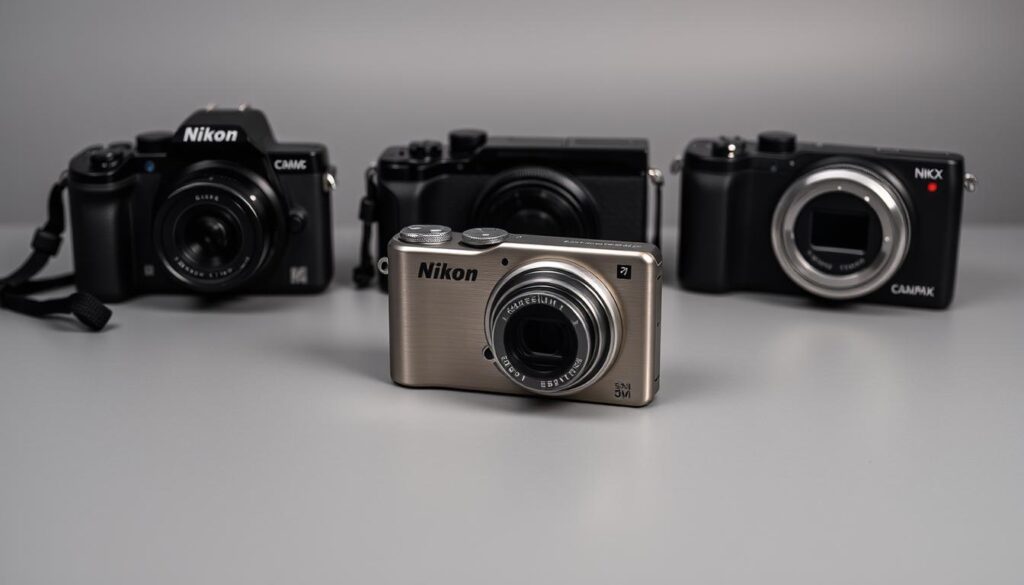
Nikon Coolpix vs Fujifilm X Series
The Fujifilm X100S stands out with its hybrid viewfinder, offering both optical and electronic options. This feature provides flexibility for photographers who prefer different shooting styles. In contrast, the Nikon Coolpix relies solely on an electronic viewfinder, which may feel limiting to some users.
Another key difference lies in the sensor size. The Fujifilm X100S uses a larger APS-C sensor, enhancing image quality in low-light conditions. The Nikon Coolpix, with its smaller 1/2.3″ sensor, struggles to match this performance, particularly in challenging lighting scenarios.
Nikon Coolpix vs Sony CyberShot
The Sony RX10 IV features a 1″ sensor, which significantly improves image quality and dynamic range. This makes it a strong contender for enthusiasts seeking superior performance. Additionally, Sony’s autofocus system is faster and more reliable, ideal for capturing fast-moving subjects.
While the Nikon Coolpix boasts a 125x optical zoom, the Sony RX10 IV offers a more balanced 25x zoom range. This trade-off ensures better image quality at the expense of extreme zoom capabilities. For those prioritising versatility over reach, Sony’s offering may be more appealing.
| Feature | Nikon Coolpix P1100 | Fujifilm X100S | Sony RX10 IV |
|---|---|---|---|
| Sensor Size | 1/2.3″ | APS-C | 1″ |
| Zoom Range | 125x | Fixed Lens | 25x |
| Viewfinder | Electronic | Hybrid | Electronic |
| Autofocus | Standard | Fast | Advanced |
| Price | £1049 | £1299 | £1499 |
When evaluating price-performance ratios, the Nikon Coolpix offers affordability but falls short in advanced features. The Fujifilm X100S and Sony RX10 IV, while pricier, provide better long-term value with their superior sensor technology and handling. For enthusiasts, these factors are crucial in making an informed decision.
Value for Money in 2025
Assessing the value of a device in today’s market requires a careful balance of cost and functionality. The Nikon Coolpix P1100, priced at £1049, and the P950, available for £849, offer distinct features that cater to different needs. However, with minimal upgrades from previous models, the question of whether they provide good value remains.
Price Point and Features
The P1100’s 125x optical zoom is its standout feature, making it ideal for wildlife and travel photography. However, its 16MP sensor, unchanged since 2018, raises concerns about its relevance in 2025. Comparatively, the P950 offers an 83x zoom at a lower price, making it a more budget-friendly option.
Second-hand models like the P1000, available under £700, provide an alternative for those seeking similar capabilities at a reduced cost. This highlights the importance of analysing cost-per-feature metrics when evaluating value.
Long-Term Investment Potential
When considering a camera as an investment, factors like depreciation and compatibility with future accessories come into play. The P1100’s USB-C charging is a step forward, but its reliance on older technology may limit its longevity.
- Depreciation rates for bridge cameras tend to be higher compared to mirrorless systems.
- Smartphone advancements offer comparable modes at a fraction of the cost.
- Repair and service considerations should be factored into the overall investment.
“The true worth of a device lies in its ability to adapt to future needs while delivering consistent performance.”
For enthusiasts, the decision to invest in the P1100 or P950 depends on their specific requirements. While these models offer specialised features, their long-term value may be overshadowed by more versatile alternatives in the market.
Pros and Cons of Nikon Coolpix Cameras
When considering a new device, weighing its strengths and weaknesses is essential. The Nikon Coolpix series offers unique features but also has notable limitations. Let’s explore the key advantages and drawbacks to help you make an informed decision.
- Unmatched optical zoom: The 125x zoom range is ideal for wildlife and travel photography, allowing you to capture distant subjects with precision.
- DSLR-style physical controls: Dual dials and well-placed buttons provide a familiar and intuitive handling experience.
- Compact design: Despite its advanced features, the device remains portable, making it suitable for on-the-go use.
- Manual modes: Creative flexibility is enhanced with options to adjust aperture, shutter speed, and other settings.
- USB-C charging: Modern connectivity ensures faster and more reliable power solutions.
Limitations
- Outdated sensor technology: The 16MP sensor, unchanged since 2018, struggles in low-light conditions and limits overall image quality.
- Limited burst shooting: With a 4fps rate, it’s less effective for capturing fast-paced action.
- Non-touch screen: The 3.2″ LCD lacks touch functionality, which can slow down operations.
- Heavy build: At over 1kg, the device may feel cumbersome for extended use.
- No lens interchangeability: The fixed lens reduces versatility compared to mirrorless systems.
Balancing portability and performance, this series excels in specific use cases but falls short in others. Its niche appeal lies in its extreme zoom capabilities, making it a favourite among wildlife and travel enthusiasts. However, for general usability, it may not meet the expectations of those seeking advanced features.
“The Nikon Coolpix series is a specialised tool, offering unparalleled zoom but limited by its outdated technology.”
In summary, the ideal user for this device is someone who prioritises optical reach and manual controls over cutting-edge image quality. For beginners or those with specific photography needs, it remains a practical choice. However, for enthusiasts seeking versatility, modern alternatives may offer better long-term value.
Conclusion: Are Nikon Coolpix Cameras Still Worth It?
In the competitive realm of photography tools, the Nikon Coolpix series continues to carve out a niche. Its superzoom capabilities remain unmatched, making it a top choice for wildlife and travel enthusiasts. However, the lack of advancements in sensor technology limits its appeal in low-light conditions.
This camera is best suited for users who prioritise optical reach over cutting-edge image quality. For those capturing distant subjects in good lighting, it delivers exceptional results. Yet, its limitations in high ISO performance and burst shooting may deter action photographers.
Alternatives like the Fujifilm X Series or Sony CyberShot offer better sensor technology and versatility. These options, though pricier, provide superior long-term value for enthusiasts seeking advanced features. For budget-conscious users, second-hand models like the P1000 are worth considering.
Looking ahead, the Nikon Coolpix series must innovate to stay relevant in a market increasingly dominated by smartphones and mirrorless systems. Its future depends on balancing its niche appeal with modern advancements. For now, it remains a solid choice for specific photography needs.
In this review, we’ve explored its strengths and weaknesses. If extreme zoom is your priority, the Nikon Coolpix is a worthy investment. For broader versatility, exploring alternatives is advisable. Learn more about its capabilities in our detailed Nikon Coolpix P950 review.
FAQ
What makes the sensor and lens technology stand out in 2025 models?
The latest models feature advanced sensors and high-quality lenses, delivering sharp images and excellent low-light performance. The combination ensures vibrant colours and detailed shots.
How effective is the zoom capability and aperture range?
These cameras offer impressive optical zoom and a wide aperture range, allowing for versatile shooting. Whether capturing distant subjects or achieving a shallow depth of field, the results are consistently professional.
Can I record high-quality videos with these cameras?
Yes, the 2025 models support 4K video recording with smooth stabilisation. Built-in connectivity options like Wi-Fi and Bluetooth make sharing and transferring footage seamless.
How does the low-light performance compare to competitors?
The cameras excel in low-light conditions, thanks to their advanced sensor technology and wide aperture. This ensures minimal noise and clear, detailed images even in challenging environments.
Is the menu system user-friendly for beginners?
Absolutely. The intuitive menu system and well-placed controls make it easy for users of all skill levels to navigate settings and capture great shots without hassle.
How does the build quality enhance usability?
The durable body and ergonomic grip ensure comfortable handling, even during extended shooting sessions. The design balances portability with robustness, making it ideal for travel and everyday use.
Are these cameras suitable for photography enthusiasts?
Yes, they cater to enthusiasts with features like manual controls, RAW shooting, and versatile modes. The balance of simplicity and advanced options makes them a great choice for those looking to grow their skills.
How do they compare to Fujifilm X Series and Sony CyberShot?
While Fujifilm and Sony offer strong alternatives, these models stand out with their user-friendly design, excellent zoom capabilities, and competitive pricing. They provide a compelling option for those seeking value and performance.
Are they a good long-term investment?
With their robust build, advanced features, and consistent updates, these cameras are a solid investment for both casual users and enthusiasts looking for reliable performance over time.
What are the main pros and cons of these cameras?
Pros include excellent image quality, versatile zoom, and user-friendly design. Cons may include slightly bulkier bodies compared to some competitors and limited customisation for advanced users.

